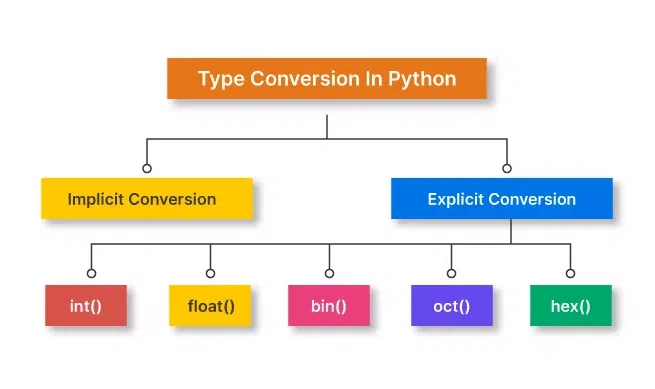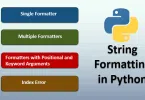In this article, you will learn about python type conversion and type casting. the uses of type conversion. Before learning conversion and casting, you should know Python Data Types.
Type Conversion
The process of converting the value of one data type (integer, string, float, etc.) to another data type is called type conversion. Python has two types of type conversion and type casting.
- Implicit Conversion
- Explicit Conversion
Implicit Conversion
In Implicit conversion, Python automatically converts one data type to another data type. This process doesn’t need any user involvement. Let’s see an example where Python promotes the conversion of the lower data type (integer) to the higher data type (float) to avoid data loss.
Example 1: Converting integer to float
|
1 2 3 4 5 6 7 8 9 10 |
num_int = 123 num_flo = 1.23 num_new = num_int + num_flo print("datatype of num_int:",type(num_int)) print("datatype of num_flo:",type(num_flo)) print("Value of num_new:",num_new) print("datatype of num_new:",type(num_new)) |
When we run the above program, the output will be:
|
1 2 3 4 5 |
datatype of num_int: <class 'int'> datatype of num_flo: <class 'float'> Value of num_new: 124.23 datatype of num_new: <class 'float'> |
In the above program,
- We add two variables, num_int and num_flo, storing the value in num_new.
- We will look at the data type of all three objects, respectively.
- In the output, we can see the data type of num_int is an
integerwhile the data type of num_flo is afloat. - Also, we can see that num_new has a
floatdata type because Python always converts smaller data types to larger data types to avoid the loss of data.
Now, let’s try adding a string and an integer and see how Python deals with it.
Example 2: Addition of string(higher) data type and integer(lower) datatype
|
1 2 3 4 5 6 7 |
num_int = 123 num_str = "456" print("Data type of num_int:",type(num_int)) print("Data type of num_str:",type(num_str)) print(num_int+num_str) |
When we run the above program, the output will be:
|
1 2 3 4 5 6 |
<samp>Data type of num_int: <class 'int'> Data type of num_str: <class 'str'> Traceback (most recent call last): File "python", line 7, in <module> TypeError: unsupported operand type(s) for +: 'int' and 'str'</samp> |
In the above program,
- We add two variables, num_int and num_str.
- As we can see from the output, we got
TypeError. Python is not able to use Implicit Conversion in such conditions. - However, Python has a solution for these types of situations, which is known as Explicit Conversion.
Explicit Conversion
In Explicit Conversion, users convert the data type of an object to the required data type. We use predefined functions like int(), float(), str(), etc, to perform explicit type conversion. This type of conversion is also called typecasting because the user casts (changes) the data type of the objects. Syntax :
|
1 |
<required_datatype>(expression) |
Typecasting can be done by assigning the required data type function to the expression.
Example 3: Addition of string and integer using explicit conversion
|
1 2 3 4 5 6 7 8 9 10 11 12 13 |
num_int = 123 num_str = "456" print("Data type of num_int:",type(num_int)) print("Data type of num_str before Type Casting:",type(num_str)) num_str = int(num_str) print("Data type of num_str after Type Casting:",type(num_str)) num_sum = num_int + num_str print("Sum of num_int and num_str:",num_sum) print("Data type of the sum:",type(num_sum)) |
When we run the above program, the output will be:
|
1 2 3 4 5 6 7 |
<samp>Data type of num_int: <class 'int'> Data type of num_str before Type Casting: <class 'str'> Data type of num_str after Type Casting: <class 'int'> Sum of num_int and num_str: 579 Data type of the sum: <class 'int'></samp> |
In the above program,
- We add num_str and num_int variables.
- We converted num_str from a string(higher) to an integer(lower) type using
int()the function to perform the addition. - After converting num_str to an integer value, Python can add these two variables.
- We got the num_sum value and data type to be an integer.
Key Points to Remember
- Type Conversion is the conversion of an object from one data type to another data type.
- Implicit Type Conversion is automatically performed by the Python interpreter.
- Python avoids the loss of data in Implicit
Type Conversion. - Explicit Type Conversion is also called Type Casting; the data types of objects are converted using predefined functions by the user.
- In Type Casting, loss of data may occur as we enforce the object to a specific data type.
Thank you for reading Python Type Conversion and Type Casting.






Leave a Comment